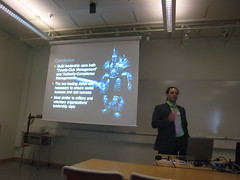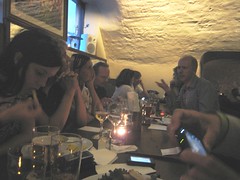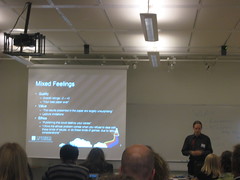The first Nordic DIGRA conference was held at DSV in Kista, Stockholm, the 16th and 17th of August. There were 12 paper presentations in a single track, two keynotes and one workshop.
The conference was really nice, and a good opportunity to connect and reconnect with researchers working in the Nordic countries. For years we have kept meeting at international conferences, far away from home, joked about that it is so strange that it is so, and that we should do more to meet here. And it seems like we are ready to do this more now; at the Nordic Digra Chapter meeting we realized that it could be possible to make the Nordic Conference an annual one. It doesn’t have to be enormous, but like this year, a single track conference during two days, some workshops, and perhaps we could add a doctoral consortium as well.
The highlight for me was Christopher Sanbergs’ keynote where he described the development of the high end technology assisted LARP Conspiracy for good. In the fiction of the the game is a dichotomy between the big evil company Blackwell Bridge who under marketing disguises of being ‘good’ sucks the life energy out of nature and people. The underdog good guys is the resistance movement. In the underlying reality the game uses actors and cellphone technology where one of the niftiest things is that they hide clues in Morse code embedded in music. Another underlying reality is that the revenue from the game is used to raise funds which benefits the real village in Zimbabwe that the fiction in the game revolves around.
Christopher got some critique after his presentation; why do this as a game instead of doing ‘good’ the traditional way through established organisations such as the red cross or amnesty? He answered by saying that they wanted to try another way of doing it, see how story and drama can be used to make a difference, how to embed situations where players are exposed to these established organisations such as Doctors for the world, and perhaps reach people who normally might not engage in charity work.
Having worked with Christopher before I know that the engagement is genuine. I’m happy that this is happening, that energy, time and thought is directed in this way. Well done Company P, Nokia, and everyone else involved.
As usual I took some random notes and photos during the conference. I throw them in here in chronological order without much editing - I’m not sure I will get around to do it otherwise.
Notes Day 1
Notes Day 2
All papers are available directly from the conference program web page. This was great, since it became so easy to glance at the publications in parallel to listening.
Blog Archive
Thursday, August 19, 2010
Wednesday, August 18, 2010
Nordic Digra Day 2 - live notes
Nordic Digra Conference, 17th August, 2010, DSV, Kista, Stockholm, Sweden. These are my live diary notes from the second day of the conference.
Paper Session: Game Design
Hagen, Designing for Player Experience: How Professional Game Developers Communicate Design Visions
//not taking notes, already read the paper (a great paper).
QA
Björn - Don’t you reiterate the auteur myth of the single genius? Two way communication?
Ulf: Usually it is a design team. If the production involve hundreds of persons all can’t have a say. But important to communicate the vision so that everyone has it, be on the same track, be involved.
Lina: Diversity?
U: I tried to tell them...
Staffan: examples seem based on GDC talks, not on the interviews?
Ulf: They talked about the same thing.
Björk, On Making Good Games - Using Player Virtue Ethics and Gameplay Design Patterns to Identify Generally Desirable Gameplay Features
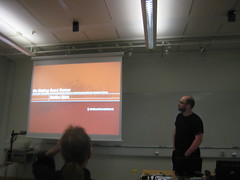
on making good games... civilization, wow, all have pros and cons, and all players don’t like al features... Farmville, Cowclicker...
Is it good if is popular? no insight in what makes it good.
good reviews?
Inherently good features in games?
Showing jesper juul’s diagram.
The MDA model.
Lazarro’s model.
Models specify emotions: these can be seen as design goals.
Turn it around, look at the player. What makes a good player (not a good human). Sicart looks at Aristotielian virtues. They are good at mid-level generally, like bravery. (too little; coward, too much; stupid)
But how recognise a good game, the game as an artifact //didn’t we have a long discussion about the expression artifact, if the game is an artifact or not in Tampere in March?
design patterns.
Looked at negative and positive patterns, finding that the positive ones tended to include social aspects.
Suggesting a way of understanding good games as games which encourage people to be good players,
QA
Jonas: so here we have Sicard, who uses Bartle’s paper from 94, and Aristotle... and then you compare them with design patters. Don’t you think the level of abstraction is too high?
Staffan: the patterns are very concrete, but I agree that there are many steps, that’s why I want to focus on the process rather than on the end result.
Jonas: it’s not hard to say that king making is a destructive pattern, don’t need Aristotle for that.
Petri: Why should players be good when they are playing? There may be a disconnection between the concepts of good games and good players. Does game play affect behaviour outside the game...?
Staffan: Not about being something or anything outside the game. In Montola’s example from yesterday people do go outside the game, or rather the effect of the game does...
Petri: but then you have selected a type of ethics that doesn’t say anything concrete.
Staffan [soldiering on]: Can narrow it down to one part, it doesn’t have to be pointless to look at a single part.
Jon: you chose to not use the MDA, instead on virtues. ... difference between the actual behaviour of players and the aesthetics the play of it result in...
Jon: Are you saying that wow is better than civ?
S: No, trying to provide a way to talk about them, to compare them. Game not better the more patterns there is in it.
Christopher Sandberg’s keynote.
The Conspiracy for Good
design for change - real change in the world. Zambia.
library in danger. enemy: Blackwell bridge.
showing film documentary style of the real village and the village school.
online puzzle. Morse-code in the music, possible to decipher hidden messages.
the leaked lobby film.
the resistance movement film
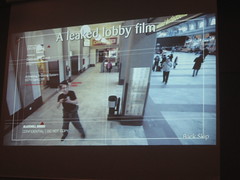
coffe: create the villains and the assistants in the fiction. “I am not a member.”
This is the setting of the game.
ppl engaging in the game hacked the blackwell security system.
track main figures //actors // on ovi-maps (a kind of google map)
geocashing in cities to find the content. Content in Africa, in five European countries, and all over London.
main character Nadira. Blackwell’s smear campaign of her.
4 events in London this summer. The technology on the mobile devices actually worked in this pilot.
Showing films from the events. A tag hidden at Tate modern.
coffe talking about object oriented story telling.
and showing photos of NPCs - real people acting as guards at the London Bridge.
//Cool with the hidden clues in the music.
live music. An opera singer singing with clues in the music.
action 2
big group of players setting up a distraction, dance parade blocking the view for the goons so resistance movement can get into a building.
Now players have a LARP head quarter, but they still need to bring Blackwell down.
action 3
hostage trade-off.
players getting pronoia - the sneaking suspicion that people are out to make your life fun.
resitance movement guy getting shot.
even 4
the take down.
marketing event. plasma screen and hor d’ouvres, blackwell organising. recruitment.
resistance movement. Hacks the press release. Showing the president shooting the resistance guy in the head.
take-down succeeded.
safehouses: 10 bars in London
easy to loos track of the zambian village during the process, but they are still there - video.
10 000 books. 50 girls got scholarship. And we built the library.
//ok, i’m about to cry.
QA
Linderoth: If change society, why not do it for real instead of making games
Coffe: there are organisations who do that, Greenpeace, amnesty etc
This is another try to do that. An experiment on how to use story. We can’t tell the real story about the mining companies in the Zambia, that would be shut down. But we could have a fictional story. Also reach people who not normally engage in this type of work to help, to change
Marie Denward: What about participants who doesn’t know that they are taking part in a game. For example in Sanningen om Marika all participants didn’t know.
Coffe: The online room for meta discussions, monitor but stay away. Talk to moderators if needed to give information. There were debriefing spaces as well around the city of London. We had police, doctors and security personnel in the background the whole time. Also in the sets there were little chance that passers-by would stumble into it. People had to make an effort to find locations where dramatic things happened. If in town there was more light weight activities and drama was constrained to video clips on cellphones.
Jon: the keys and the clues... comments on the design choices? Some are not so obvious.
Coffe: clear game markers when needed. Some were obvious, but at other points we put the sign/logo. It is important to sustain the magic circle we have found in this type of production.
Staffan: how did you recruit players? How many did you have?
C: lots of different rabbit holes. The web page. (what membership is denied). Downloads to cell phones. a downloaded game which gave clues. 1/4 million downloads. A music site (400 k users) hiding clues in music. New compositions made. A plethora of things. Some people came from Alaska or Canada.
Tanja: Did you get stuck with players, did you need to do last minute changes?
C: yes, always. A time travel problem. Want to get as much as possible done in pre-production, but then you are real-time in the street - did people really find that geocash?
We did on the fly rewriting of the story and sent of actors to ‘fix’ the progression of the story.
Maria D: back to sanningen om Marika, there you also had a chance to have an impact on politics, on real world. Here, books and library, but what about the participants?
C: I’m not sure. We didn’t tell people to “do good”. But you were given clues by for example volunteer to give out flyers for doctors of the world. Players see it as source materials for their characters... exposing people to facts and organisations.
me: was there a possibility that the take-down would fail?
c: yes. There are always crazy people. Griefers destroying. Ways to orchestrate these people, learnt a lot by these production. Give griefers extra special personal tasks to perform so they can still have fun without disrupting.
www.thecompanyp.com
Paper Session: Massively-Multiplayer Online Games
field study of a café in stockholm.
why do people go to a game café to play? Many have the same ones at home along with fast internet connection and good hardware, but they still go to the café. 5 cafés in stockholm. Late opening hours, even nighttime, it is very accessible. Targets young people.
The third place. Oldenburg 1997. ‘the great good place’
young ppl restricted at home - gaming restricted, game time limited. At the game cafe they felt they could manage their own time.
//How does this deepen our understanding of third places or gaming cafés?
QA
Q: Genderdistribution?
Fatima: 3% girls. Didn't come in groups, either alone or with boy friend.
Q: since it costs money, do people hang around without playing, just socializing?
F: no.
Q: Spectatorship? Can be problematic to feel to be under scrutiny. In third place concept, so positive... but at these places people can be very harsh to each other.
F: good point. I didn’t see that so much in my study, perhaps because it was an older crowd in my study. It is a quite exclusive crowd. Officially open to everyone, but not so culturally open to girls and women.
Q how long were the interviews?
F 50 -55 interviews which sometimes lasted for long, since i interviewed them while they were playing.
Q: structured interviews?
F: semi structured
Q: you could lift the analysis, need to problematise more.
Paper Session: Game Design
Hagen, Designing for Player Experience: How Professional Game Developers Communicate Design Visions
//not taking notes, already read the paper (a great paper).
QA
Björn - Don’t you reiterate the auteur myth of the single genius? Two way communication?
Ulf: Usually it is a design team. If the production involve hundreds of persons all can’t have a say. But important to communicate the vision so that everyone has it, be on the same track, be involved.
Lina: Diversity?
U: I tried to tell them...
Staffan: examples seem based on GDC talks, not on the interviews?
Ulf: They talked about the same thing.
nationally funded project, Nokia and 2 universities
experimental game design.
what is game design as an activity?
showing the waterfall model.
the iterative model.
open the black box of game design.
no one can stop the hamster - low-fi augmented reality game. Played at a big convention in Tampere.
markers with different shapes that could be recognised by cellphone cameras.
Catch the worm holes by using the camera. Build up energy in camera by moving it and then press the button to capture at the right moment.
documentation of work. Used body storming.
SW sketches.
kept the whole documentation of the process.
then used two models to analyse the data.
Löwgren and Stolterman; vision - , operative image - (the first explicit operative proto, like body storming and sketches on whiteboards, user interface-sketch), - 3 Specfication
In the work the team leaped between layers, but ended up with an operative image that could be used to construct the final artefact.
Lawson’s model of designing. Not sequential.
reflection-in-action. Excerpts from design diaries.
QA
Jesper: assuming you read the models before you did the design work. Did this have an impact?
Jussi: We did the design and documenting before we looked at the model.
Staffan: If you chose models in retrospect, wouldn’t this have an impact on the result of the analysis.
Jussi: yes, [then list of models, like buxton’s] but they didn’t give us the same insight as these two models.
Jon: What kind of refinement to these models did you find?
Jussi: we didn’t make that explicit, but it has an implicit effect, it can help us to refine methods and techniques in future work. Co-workers in this proj are doing their phd theses on the topic of design processes.
experimental game design.
what is game design as an activity?
showing the waterfall model.
the iterative model.
open the black box of game design.
no one can stop the hamster - low-fi augmented reality game. Played at a big convention in Tampere.
markers with different shapes that could be recognised by cellphone cameras.
Catch the worm holes by using the camera. Build up energy in camera by moving it and then press the button to capture at the right moment.
documentation of work. Used body storming.
SW sketches.
kept the whole documentation of the process.
then used two models to analyse the data.
Löwgren and Stolterman; vision - , operative image - (the first explicit operative proto, like body storming and sketches on whiteboards, user interface-sketch), - 3 Specfication
In the work the team leaped between layers, but ended up with an operative image that could be used to construct the final artefact.
Lawson’s model of designing. Not sequential.
reflection-in-action. Excerpts from design diaries.
QA
Jesper: assuming you read the models before you did the design work. Did this have an impact?
Jussi: We did the design and documenting before we looked at the model.
Staffan: If you chose models in retrospect, wouldn’t this have an impact on the result of the analysis.
Jussi: yes, [then list of models, like buxton’s] but they didn’t give us the same insight as these two models.
Jon: What kind of refinement to these models did you find?
Jussi: we didn’t make that explicit, but it has an implicit effect, it can help us to refine methods and techniques in future work. Co-workers in this proj are doing their phd theses on the topic of design processes.
Björk, On Making Good Games - Using Player Virtue Ethics and Gameplay Design Patterns to Identify Generally Desirable Gameplay Features

on making good games... civilization, wow, all have pros and cons, and all players don’t like al features... Farmville, Cowclicker...
Is it good if is popular? no insight in what makes it good.
good reviews?
Inherently good features in games?
Showing jesper juul’s diagram.
The MDA model.
Lazarro’s model.
Models specify emotions: these can be seen as design goals.
Turn it around, look at the player. What makes a good player (not a good human). Sicart looks at Aristotielian virtues. They are good at mid-level generally, like bravery. (too little; coward, too much; stupid)
But how recognise a good game, the game as an artifact //didn’t we have a long discussion about the expression artifact, if the game is an artifact or not in Tampere in March?
design patterns.
Looked at negative and positive patterns, finding that the positive ones tended to include social aspects.
Suggesting a way of understanding good games as games which encourage people to be good players,
QA
Jonas: so here we have Sicard, who uses Bartle’s paper from 94, and Aristotle... and then you compare them with design patters. Don’t you think the level of abstraction is too high?
Staffan: the patterns are very concrete, but I agree that there are many steps, that’s why I want to focus on the process rather than on the end result.
Jonas: it’s not hard to say that king making is a destructive pattern, don’t need Aristotle for that.
Petri: Why should players be good when they are playing? There may be a disconnection between the concepts of good games and good players. Does game play affect behaviour outside the game...?
Staffan: Not about being something or anything outside the game. In Montola’s example from yesterday people do go outside the game, or rather the effect of the game does...
Petri: but then you have selected a type of ethics that doesn’t say anything concrete.
Staffan [soldiering on]: Can narrow it down to one part, it doesn’t have to be pointless to look at a single part.
Jon: you chose to not use the MDA, instead on virtues. ... difference between the actual behaviour of players and the aesthetics the play of it result in...
Jon: Are you saying that wow is better than civ?
S: No, trying to provide a way to talk about them, to compare them. Game not better the more patterns there is in it.
Christopher Sandberg’s keynote.
The Conspiracy for Good
design for change - real change in the world. Zambia.
library in danger. enemy: Blackwell bridge.
showing film documentary style of the real village and the village school.
online puzzle. Morse-code in the music, possible to decipher hidden messages.
the leaked lobby film.
the resistance movement film

coffe: create the villains and the assistants in the fiction. “I am not a member.”
This is the setting of the game.
ppl engaging in the game hacked the blackwell security system.
track main figures //actors // on ovi-maps (a kind of google map)
geocashing in cities to find the content. Content in Africa, in five European countries, and all over London.
main character Nadira. Blackwell’s smear campaign of her.
4 events in London this summer. The technology on the mobile devices actually worked in this pilot.
Showing films from the events. A tag hidden at Tate modern.
coffe talking about object oriented story telling.
and showing photos of NPCs - real people acting as guards at the London Bridge.
//Cool with the hidden clues in the music.
live music. An opera singer singing with clues in the music.
action 2
big group of players setting up a distraction, dance parade blocking the view for the goons so resistance movement can get into a building.
Now players have a LARP head quarter, but they still need to bring Blackwell down.
action 3
hostage trade-off.
players getting pronoia - the sneaking suspicion that people are out to make your life fun.
resitance movement guy getting shot.
even 4
the take down.
marketing event. plasma screen and hor d’ouvres, blackwell organising. recruitment.
resistance movement. Hacks the press release. Showing the president shooting the resistance guy in the head.
take-down succeeded.
safehouses: 10 bars in London
easy to loos track of the zambian village during the process, but they are still there - video.
10 000 books. 50 girls got scholarship. And we built the library.
//ok, i’m about to cry.
QA
Linderoth: If change society, why not do it for real instead of making games
Coffe: there are organisations who do that, Greenpeace, amnesty etc
This is another try to do that. An experiment on how to use story. We can’t tell the real story about the mining companies in the Zambia, that would be shut down. But we could have a fictional story. Also reach people who not normally engage in this type of work to help, to change
Marie Denward: What about participants who doesn’t know that they are taking part in a game. For example in Sanningen om Marika all participants didn’t know.
Coffe: The online room for meta discussions, monitor but stay away. Talk to moderators if needed to give information. There were debriefing spaces as well around the city of London. We had police, doctors and security personnel in the background the whole time. Also in the sets there were little chance that passers-by would stumble into it. People had to make an effort to find locations where dramatic things happened. If in town there was more light weight activities and drama was constrained to video clips on cellphones.
Jon: the keys and the clues... comments on the design choices? Some are not so obvious.
Coffe: clear game markers when needed. Some were obvious, but at other points we put the sign/logo. It is important to sustain the magic circle we have found in this type of production.
Staffan: how did you recruit players? How many did you have?
C: lots of different rabbit holes. The web page. (what membership is denied). Downloads to cell phones. a downloaded game which gave clues. 1/4 million downloads. A music site (400 k users) hiding clues in music. New compositions made. A plethora of things. Some people came from Alaska or Canada.
Tanja: Did you get stuck with players, did you need to do last minute changes?
C: yes, always. A time travel problem. Want to get as much as possible done in pre-production, but then you are real-time in the street - did people really find that geocash?
We did on the fly rewriting of the story and sent of actors to ‘fix’ the progression of the story.
Maria D: back to sanningen om Marika, there you also had a chance to have an impact on politics, on real world. Here, books and library, but what about the participants?
C: I’m not sure. We didn’t tell people to “do good”. But you were given clues by for example volunteer to give out flyers for doctors of the world. Players see it as source materials for their characters... exposing people to facts and organisations.
me: was there a possibility that the take-down would fail?
c: yes. There are always crazy people. Griefers destroying. Ways to orchestrate these people, learnt a lot by these production. Give griefers extra special personal tasks to perform so they can still have fun without disrupting.
www.thecompanyp.com
Paper Session: Massively-Multiplayer Online Games
country-club style leadership and authority compliance style leadership conducted by guild leaders depending on in-game situations; in raids and outside the raids.
Members of different types of guilds interviewed.
Interviews with real-life leaders in different types of organisations. Big difference is that in a game the guild leader doesn’t have to report to anyone else, such as stockholders. Interviewed 6 leaders, but the useful ones in terms of similarity was the air-force and a student radio.
QA
Carl: compare raid group to ideological counterparts? Such as antifascist action? Similar janus-faced leadership in such groups.
P: Interesting
Jon: small companies/large companies?
P: I looked at that, but even in a small organisation there was a difference in the stake holding situation.
Jon: Guild leading as a reference in real life...?
P: my examples were where the same persons were raid- and guild-leaders. Useful to train different leadership styles depending on context.
Jessica: real life examples of people using it in their CVs?
P: not sure of statistics or examples of that
Q: Comment: I heard of an example where a large company in the US did hire someone based on his guild leading experience
P: please send ref!
Ulrika: Surgery?
P: Interesting!
Björn: time constraint. Can make comparison to any group that involves need of result of work and a time constraint? Coordinate people. Perhaps not any job but... a busy restaurant, at lunch hour more intense.
P: you wouldn’t kick an employee out of the restaurant if he stopped to chit-chat once...
Members of different types of guilds interviewed.
Interviews with real-life leaders in different types of organisations. Big difference is that in a game the guild leader doesn’t have to report to anyone else, such as stockholders. Interviewed 6 leaders, but the useful ones in terms of similarity was the air-force and a student radio.
QA
Carl: compare raid group to ideological counterparts? Such as antifascist action? Similar janus-faced leadership in such groups.
P: Interesting
Jon: small companies/large companies?
P: I looked at that, but even in a small organisation there was a difference in the stake holding situation.
Jon: Guild leading as a reference in real life...?
P: my examples were where the same persons were raid- and guild-leaders. Useful to train different leadership styles depending on context.
Jessica: real life examples of people using it in their CVs?
P: not sure of statistics or examples of that
Q: Comment: I heard of an example where a large company in the US did hire someone based on his guild leading experience
P: please send ref!
Ulrika: Surgery?
P: Interesting!
Björn: time constraint. Can make comparison to any group that involves need of result of work and a time constraint? Coordinate people. Perhaps not any job but... a busy restaurant, at lunch hour more intense.
P: you wouldn’t kick an employee out of the restaurant if he stopped to chit-chat once...
Eklund and Johansson, What Happened with Social Play? A study of social interaction in temporary group formation (PUG) in World of Warcraft
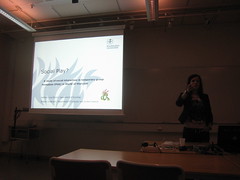

Structures of social interactions in pick-up groups on WoW.
Dungeons in heroic mode. Alternative endgame to raiding.
LfG system that came with the Burning Crusade expansion.
LfG system took in players from different servers meaning that the social control was lessened. No reputation to be wrecked if on different server.
Instrumental interaction. Ppl didn’t even say hi or goodbye. Low social investment. Grinding. Run through as fast as possible and get as much rewards as possible. Even in down-time, waiting for replacement to the group, people didn’t chat even if they were clearly bored (jumping around, but not talking).
QA:
AnneMette: No social norms? Clearly there would be some norms, what do you put in the word?
Magnus: All part of different norm systems. In this situation we can’t see *what* norms are used.
Jonas L: You can lift the level of analysis if you relate it to the economic models that underlie this type of game, that it is made more and more casual to draw more players.
Ulrika: You don’t necessarily need to see chat as the primary way of communication when you look at social interaction. How are you going to continue your work? Non verbal communication?
Lina: Probably not do interaction analysis. Players know what to do in the dungeons, they just run along and do it. They don’t stop and look behind to see if the others are there following...
Patrick: A J said, WoW changes, the unsocial play style... the game is old, people already have their social lives worked out there. If two guilidies happen to be in the same PUG they talk on an own channel, and if they are ‘alone’ in the PUG they might engage in guildchat in parallell... so social interaction may happen
Jon. People do strange things in PUGs. I happened to have my fishing rod equipped and coming from an RP server, that struck up conversation in the group.
Ulf: Final comment: Next step to replace the players with NPCs if they do single player gaming among each other.
Dungeons in heroic mode. Alternative endgame to raiding.
LfG system that came with the Burning Crusade expansion.
LfG system took in players from different servers meaning that the social control was lessened. No reputation to be wrecked if on different server.
Instrumental interaction. Ppl didn’t even say hi or goodbye. Low social investment. Grinding. Run through as fast as possible and get as much rewards as possible. Even in down-time, waiting for replacement to the group, people didn’t chat even if they were clearly bored (jumping around, but not talking).
QA:
AnneMette: No social norms? Clearly there would be some norms, what do you put in the word?
Magnus: All part of different norm systems. In this situation we can’t see *what* norms are used.
Jonas L: You can lift the level of analysis if you relate it to the economic models that underlie this type of game, that it is made more and more casual to draw more players.
Ulrika: You don’t necessarily need to see chat as the primary way of communication when you look at social interaction. How are you going to continue your work? Non verbal communication?
Lina: Probably not do interaction analysis. Players know what to do in the dungeons, they just run along and do it. They don’t stop and look behind to see if the others are there following...
Patrick: A J said, WoW changes, the unsocial play style... the game is old, people already have their social lives worked out there. If two guilidies happen to be in the same PUG they talk on an own channel, and if they are ‘alone’ in the PUG they might engage in guildchat in parallell... so social interaction may happen
Jon. People do strange things in PUGs. I happened to have my fishing rod equipped and coming from an RP server, that struck up conversation in the group.
Ulf: Final comment: Next step to replace the players with NPCs if they do single player gaming among each other.
• Johansson and Verhagen, And Justice for All - the 10 commandments of Online Games, and then some…
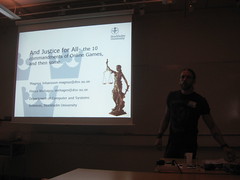
rules created by clans and guilds in online games. Ie the rules defined by players rather than the game design.
Data collected from clan and guild sites that had information on rules.
Looked and different mmo guilds and fps clans.
//...spending a lot of time talking about previous work.
QA:
Patrick: During the act of play when focus is on effectiveness, many rules are about that, while other rules apply in social situations, could you comment?
Magnus: Yes many similarities.
Mats: ganking and griefplay... how define when it happens
Magnus: depends on who is at the receiving end. And different groups and contexts. For example, a group what has ganking as its goal.

rules created by clans and guilds in online games. Ie the rules defined by players rather than the game design.
Data collected from clan and guild sites that had information on rules.
Looked and different mmo guilds and fps clans.
//...spending a lot of time talking about previous work.
QA:
Patrick: During the act of play when focus is on effectiveness, many rules are about that, while other rules apply in social situations, could you comment?
Magnus: Yes many similarities.
Mats: ganking and griefplay... how define when it happens
Magnus: depends on who is at the receiving end. And different groups and contexts. For example, a group what has ganking as its goal.
Paper Session: Case Studies
Waern, “I'm in love with someone that doesn't exist!!” Bleed in the context of a Computer Game
annika stats with showing a violent promo movie.
then a clip of a conversation, a man in love trying to express it verbally. (“alistair romance scene” youtube.)

the cheesiness of romance in games.
romance occurs often as a narrative component in plot lines. Often optional side plot lines. Sometimes part of the game play mechanism.
Player characters. Sociolotron.
Showing a quote of someone in love with the character Alistair - how can this happen?
Searched for comments about emotional reactions on forums and blogs.
causes for bleed-:
safe zone. True emotions, but no real concrete romance in real life. Like teen age girl idolisation. cyber-romance, role-played romance.
character as projected identity. a theoretical identity that player wishes to be in the context of the game world.
partial agency. feel in control, but then not being able to control. interesting frustration.
Annika not sure how much of this was intended in the design.
QA
AnneMarie: what difference does it make if it is intended?
A: im interested because of the design-perspective I have
Staffan: ...
A: yes you choose to engage
Jesper: the term ‘Bleed’, how would you relate the term ...
A: not my purpose with the papers, it is one of these mushy terms.... relate to the false belief that we would only have one identity...
Patrick: this mechanism in a multi-player game?
A: most causes of romance bleed are multi-player. Interesting here is that it only is a single player game so it is easier to analyse. in multi-player you also perform towards other players, creates a slightly different context.
then a clip of a conversation, a man in love trying to express it verbally. (“alistair romance scene” youtube.)

the cheesiness of romance in games.
romance occurs often as a narrative component in plot lines. Often optional side plot lines. Sometimes part of the game play mechanism.
Player characters. Sociolotron.
Showing a quote of someone in love with the character Alistair - how can this happen?
Searched for comments about emotional reactions on forums and blogs.
causes for bleed-:
safe zone. True emotions, but no real concrete romance in real life. Like teen age girl idolisation. cyber-romance, role-played romance.
character as projected identity. a theoretical identity that player wishes to be in the context of the game world.
partial agency. feel in control, but then not being able to control. interesting frustration.
Annika not sure how much of this was intended in the design.
QA
AnneMarie: what difference does it make if it is intended?
A: im interested because of the design-perspective I have
Staffan: ...
A: yes you choose to engage
Jesper: the term ‘Bleed’, how would you relate the term ...
A: not my purpose with the papers, it is one of these mushy terms.... relate to the false belief that we would only have one identity...
Patrick: this mechanism in a multi-player game?
A: most causes of romance bleed are multi-player. Interesting here is that it only is a single player game so it is easier to analyse. in multi-player you also perform towards other players, creates a slightly different context.
Jonsson, The Nook. A Fieldstudy of the Game Café as a Third Place
field study of a café in stockholm.
why do people go to a game café to play? Many have the same ones at home along with fast internet connection and good hardware, but they still go to the café. 5 cafés in stockholm. Late opening hours, even nighttime, it is very accessible. Targets young people.
The third place. Oldenburg 1997. ‘the great good place’
young ppl restricted at home - gaming restricted, game time limited. At the game cafe they felt they could manage their own time.
//How does this deepen our understanding of third places or gaming cafés?
QA
Q: Genderdistribution?
Fatima: 3% girls. Didn't come in groups, either alone or with boy friend.
Q: since it costs money, do people hang around without playing, just socializing?
F: no.
Q: Spectatorship? Can be problematic to feel to be under scrutiny. In third place concept, so positive... but at these places people can be very harsh to each other.
F: good point. I didn’t see that so much in my study, perhaps because it was an older crowd in my study. It is a quite exclusive crowd. Officially open to everyone, but not so culturally open to girls and women.
Q how long were the interviews?
F 50 -55 interviews which sometimes lasted for long, since i interviewed them while they were playing.
Q: structured interviews?
F: semi structured
Q: you could lift the analysis, need to problematise more.
Later on:
Nordic Digra Day 1 - live notes
Nordic Digra Conference, 16th August, 2010, DSV, Kista, Stockholm, Sweden.
These are my live diary notes from the first day of the conference.
I started out by going to the Nordic Digra Chapter meeting, and then catching the second half of the workshop on Collecting and analyzing video data in game studies led by Jonas Linderoth, Ulrika Bennerstedt & Björn Sjöblom. We looked at videos and transcripts of players playing a console game. I was in the group Jonas moderated.
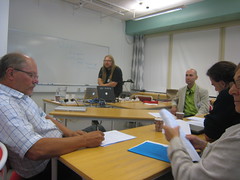
Next was Jesper Juul’s keynote where he took a large perspective and talked about the notion of casual games, how it has emerged during the past five years, and how the term is used by among others hard core gamers.
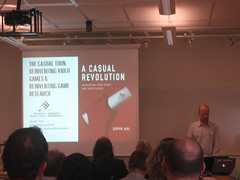
Paper Session: Playing Experience
Kivikangas et al., Psychophysiological method in studying game experience
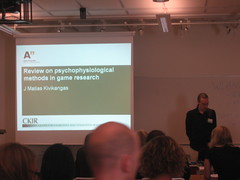
What do we really know? Not much. Because studies are scattered. Different approaches. Little accumulated knowledge.
Noergaard, Stillborn Gamers? Writing a Birth Certificate for Corporeality and Motility in Game Studies
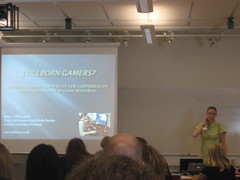
introducing with a video clip.
“the gamer game” Arguing that the corporality, the motion of the body of the player is not studied enough. Rythm.
Linderoth, Why gamers don’t learn more: An ecological approach to games as learning environments
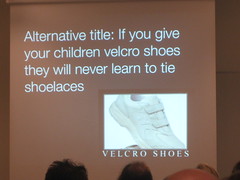
about learning - alternative title about that children don’t learn to tie their shoes if they get welcro shoe things. Games. Gibson. Ecological systems. Affordances. They are relative. Not objective properties of an environment. Always relative to an agent. Affordance: the ‘empty fit’ between the agent and the environment. The affordances needs to be discovered. Learn to realize the affordances. Rock-climbing for example. Need to learn what surfaces to grip. Perception and action are closely related. We act upon affordances.
exploratory actions - learn what performances are afforded
performatory actions - already learned the affordance.
Example video clip where a player tries to shoot a couple human-like figures, but nothing happens. He realizes there is no affordance there. Then discovers that only objects with arrows on have affordances. highlighted objects, points of interest - games use good codes for signalling that there is an affordance. makes argument that ‘avatars are the tools we use in digital environment’dynamics of the game play can be guilt into the avatar. Gain different affordances...many ways to change the affordances....
QA
Jesper: but you ...talk about a role-playing game? whith characters skill progression?
//Association to the bioware-speech at gdc when avatar motion and targeting was enhanced to make players feel more hero-like. I feel that I don’t understand what point Jonas is making, I’ll need to read the paper. I associate to the design of the action potential of avatars and world designs... but everybody knows this, it can’t be Jonas’ point ok... What he says now that this is something UNIQUE in games, that there is these both explorative and performative affordances/actions. Ok. I’ll read the paper and I will keep quiet now.
Paper Session: Role-Playing Games
Bergström et al., Undercurrents A Computer-Based Gameplay Tool to Support Tabletop Roleplaying
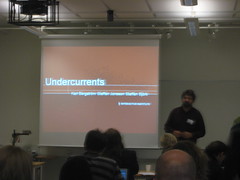
//I think it is the same tools as they showed at the Tampere workshop?...yes it is.
Abstract:"This paper introduces Undercurrents, a computer-based gameplay tool for providing additional communication and media streams during tabletop roleplaying sessions. [...] "
B: Players use a surprisingly high amount of technology when role-playing today as opposed to just a few years ago, perhaps because of the rise of ubiquitous computing.
Reception at DAC in Kista.
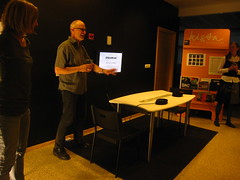
The reception was held in the new Digital Arts showroom in Kista that Ingvar and his group at the Interactive Instititute has built up together with DSV. It was really really nice, I immediately felt good vibes when entering. They’ve managed to create a good balance of the works exhibited; both historically important works, a variety of new and quirky projects on display and pieces which are fun to interact with, such as the wall climbing game. Ingvar and one of his co-workers showed us around. Also, Crister Engström from Dreamhack gave a presentation and invited everyone warmly to Dreamhack, next time is in November. I came to think about TL's and Emma's paper from FDG. I hope I'll be able to go there sometime, DH has this tendency to clash with other stuff I need to travel to.
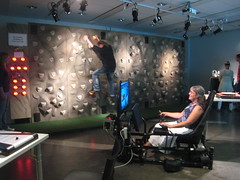
These are my live diary notes from the first day of the conference.
I started out by going to the Nordic Digra Chapter meeting, and then catching the second half of the workshop on Collecting and analyzing video data in game studies led by Jonas Linderoth, Ulrika Bennerstedt & Björn Sjöblom. We looked at videos and transcripts of players playing a console game. I was in the group Jonas moderated.

Next was Jesper Juul’s keynote where he took a large perspective and talked about the notion of casual games, how it has emerged during the past five years, and how the term is used by among others hard core gamers.

Paper Session: Playing Experience
Kivikangas et al., Psychophysiological method in studying game experience

What do we really know? Not much. Because studies are scattered. Different approaches. Little accumulated knowledge.
Also: it is difficult. Not well defined. Own theories. Not clear what theories are effective. Not easy to combine with game studies.
Measure physiology to study psychology. The ‘bible’ by Cacioppo (2007) doesn’t have a word about games.
so why use them; objective except for the researchers interpretations
How use them? Experimental and applied research. Study the experience: emotions and attention. Problem example: the muscle on the brow which is a measure of displeasure is also the measure of concentration. There is not one to one relations between physiology and psychology. Need to be interpreted, and the experiments must be carefully designed.
Many methodological problems.
Many methodological problems.
Why bother, what are they good for?
They are complicated, but when used properly they are powerful. No other methods are objective precise etc.
They are complicated, but when used properly they are powerful. No other methods are objective precise etc.
Future: hopes for more experimental research so knowledge can be accumulated.
//Great that they made a review paper. Helpful. I'll read it.
//Great that they made a review paper. Helpful. I'll read it.
Noergaard, Stillborn Gamers? Writing a Birth Certificate for Corporeality and Motility in Game Studies

introducing with a video clip.
“the gamer game” Arguing that the corporality, the motion of the body of the player is not studied enough. Rythm.
Marcus: connects to our (GS community) embarrassing ignorance of sport studies.
Linderoth, Why gamers don’t learn more: An ecological approach to games as learning environments

about learning - alternative title about that children don’t learn to tie their shoes if they get welcro shoe things. Games. Gibson. Ecological systems. Affordances. They are relative. Not objective properties of an environment. Always relative to an agent. Affordance: the ‘empty fit’ between the agent and the environment. The affordances needs to be discovered. Learn to realize the affordances. Rock-climbing for example. Need to learn what surfaces to grip. Perception and action are closely related. We act upon affordances.
exploratory actions - learn what performances are afforded
performatory actions - already learned the affordance.
Example video clip where a player tries to shoot a couple human-like figures, but nothing happens. He realizes there is no affordance there. Then discovers that only objects with arrows on have affordances. highlighted objects, points of interest - games use good codes for signalling that there is an affordance. makes argument that ‘avatars are the tools we use in digital environment’dynamics of the game play can be guilt into the avatar. Gain different affordances...many ways to change the affordances....
QA
Jesper: but you ...talk about a role-playing game? whith characters skill progression?
//Association to the bioware-speech at gdc when avatar motion and targeting was enhanced to make players feel more hero-like. I feel that I don’t understand what point Jonas is making, I’ll need to read the paper. I associate to the design of the action potential of avatars and world designs... but everybody knows this, it can’t be Jonas’ point ok... What he says now that this is something UNIQUE in games, that there is these both explorative and performative affordances/actions. Ok. I’ll read the paper and I will keep quiet now.
Paper Session: Role-Playing Games
Bergström et al., Undercurrents A Computer-Based Gameplay Tool to Support Tabletop Roleplaying

//I think it is the same tools as they showed at the Tampere workshop?...yes it is.
Abstract:"This paper introduces Undercurrents, a computer-based gameplay tool for providing additional communication and media streams during tabletop roleplaying sessions. [...] "
B: Players use a surprisingly high amount of technology when role-playing today as opposed to just a few years ago, perhaps because of the rise of ubiquitous computing.
Ground Zero. Much discussed LARP.
// i recognise Marcus’ talk from his speech at digra last year.
The Journey - the rape game. These types of games are gratifying but not fun. “The Journey”, “Gang Rape”.
Comparable to shindlers list and other strong emotional experiences. “They don’t fit into the categories for playful experience research I made.”
QA
Jonas Linderoth: But is it game - what if it was called an educational drama?
MM: therapist wanted the CDs, terapist specialising in rape victims.
Annika: It is illegal to play them, so be careful.
MM: the painstation (electronic chock in pong game - chock when fail.)
me: train. Brathwaite.
Gunilla: Why?
MM: artistic experience.
Marie: strong political statement.
Designer is present. Wrigstad.
// i recognise Marcus’ talk from his speech at digra last year.
The Journey - the rape game. These types of games are gratifying but not fun. “The Journey”, “Gang Rape”.
Comparable to shindlers list and other strong emotional experiences. “They don’t fit into the categories for playful experience research I made.”
QA
Jonas Linderoth: But is it game - what if it was called an educational drama?
MM: therapist wanted the CDs, terapist specialising in rape victims.
Annika: It is illegal to play them, so be careful.
MM: the painstation (electronic chock in pong game - chock when fail.)
me: train. Brathwaite.
Gunilla: Why?
MM: artistic experience.
Marie: strong political statement.
Designer is present. Wrigstad.
Reception at DAC in Kista.

The reception was held in the new Digital Arts showroom in Kista that Ingvar and his group at the Interactive Instititute has built up together with DSV. It was really really nice, I immediately felt good vibes when entering. They’ve managed to create a good balance of the works exhibited; both historically important works, a variety of new and quirky projects on display and pieces which are fun to interact with, such as the wall climbing game. Ingvar and one of his co-workers showed us around. Also, Crister Engström from Dreamhack gave a presentation and invited everyone warmly to Dreamhack, next time is in November. I came to think about TL's and Emma's paper from FDG. I hope I'll be able to go there sometime, DH has this tendency to clash with other stuff I need to travel to.

Subscribe to:
Comments (Atom)

